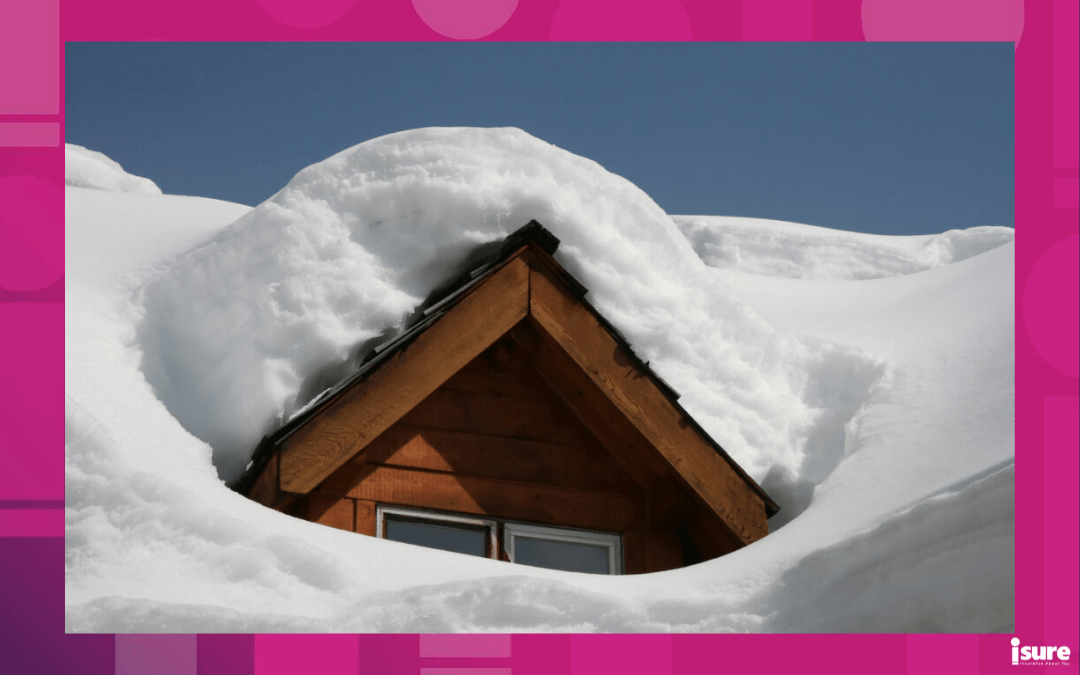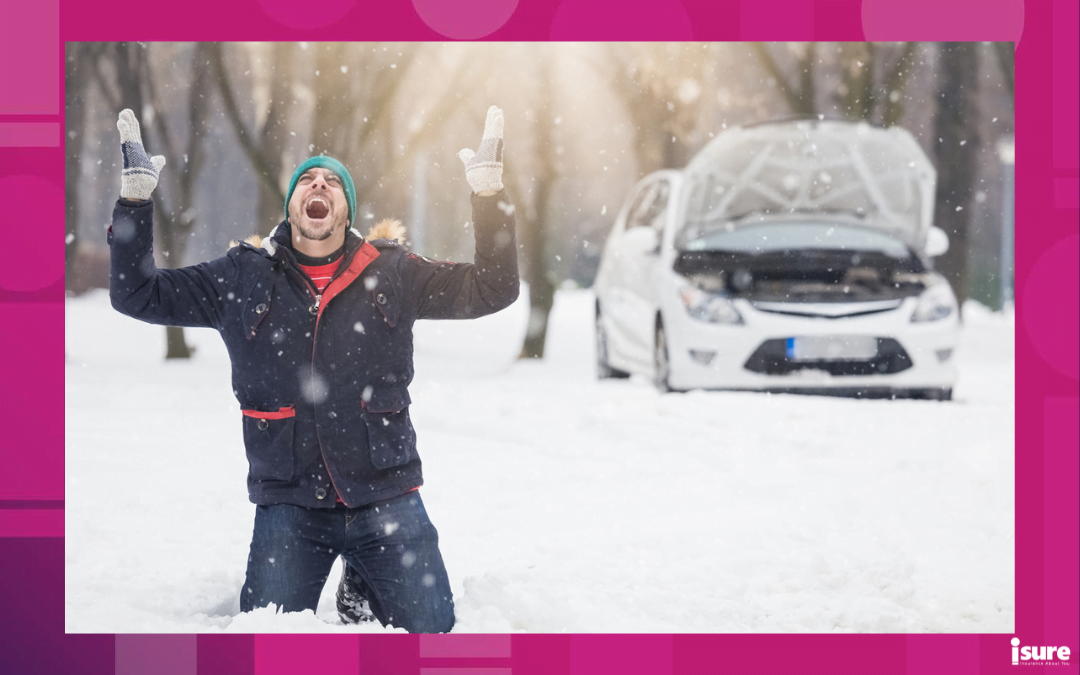Nothing says winter like your home being blanketed by a layer of fluffy, white snow. As magical as it may look, heavy snowfall on your roof can lead to weighty consequences. Not only is it a hassle to deal with, but it can be pricey to repair. Let’s examine some of the risks of snow accumulation, and tips on how to help protect your home from snow damage.
Generally speaking, Canadian homes are designed to withstand the harshest of winters. But snow and ice can easily build up, and all that extra weight can damage your roof. It’s time to act when there’s around 70 cm (about 2 feet) of snow or 5 cm (about 2 inches) of ice on the roof. In winter, a mild spell and freezing rain are common occurrences after a snowfall. Unfortunately, they can be followed by a deep freeze. This damaging cycle promotes the formation of ice dams which, combined with the snow, prevents normal surface runoff from roofs and may cause water to seep in. Let’s take a look at the four most common types of damage that heavy snowfall and harsh winter temperatures may cause:
What are the most common types of snow damage?
1. Snow damage
Snow damage occurs when heavy snowfall accumulates on your roof. Damage increases when freezing rain and high winds are combined with snowfall weight. While we may not be able to predict or control the weather, we can remain vigilant by watching for signs of structural damage to your home due to snow. Here’s what to look for:
- Cracks that appear and run along your interior walls
- Doors that either open by themselves or stay stuck
- Creaks that are loud enough to be heard
- Warped ceilings
Prevention tip: Trim trees and branches that are close to your home or rub on your roof. The winter weather can sometimes result in them falling and potentially damaging your home. Additionally, hire a professional to clear your roof to avoid injury.
2. Roof damage and water seepage
According to the Insurance Bureau of Canada, in recent years, losses caused by weather events — particularly water damage claims — have increased dramatically in Canada. No matter how much snow or ice there is, be on the lookout for signs that water is seeping through the roof. If you’re worried about the risk of water seepage or buildup of snow, consult a building expert. Make sure this is done as soon as possible to prevent further damage from occurring. Check the ceiling and walls on the top floor of your house for:
- Water stains or rings
- Blistering
- Water droplets
- Moisture surrounding nail pops
Prevention tip: Always pay extra attention to your eavestroughs, making sure they are regularly cleared out. Clogged eavestroughs can result in heavy water build up on your roof, resulting in potential flooding and water damage. Stuff such as fallen leaves and twigs can regularly prevent water from draining off of your roof, resulting in some pricey consequences.
3. Ice dams
Those icicles hanging from the eavestrough may look pretty, but they spell trouble. They can be a sign of a potentially serious problem: ice dams. An ice dam tends to be caused by poor ventilation or insulation in the attic. If there’s an ice dam on your roof, it stops melting snow from draining off the roof. This means water can accumulate and seep through the walls and ceiling into your home. Luckily, we have some tips to help prevent damage caused by ice dams:
- Regularly check the edges of your roof to make sure no ice dams have formed.
- Inspect the attic and seal any openings that can let out warm air from your home.
- Make sure the attic has proper ventilation and that the attic floor is well-insulated to prevent heat from escaping inside the home through the roof. This can form a layer of ice, which can quickly become an ice dam.
Prevention tip: We recommend that you hire a professional with the right equipment and knowledge of safety procedures to remove ice dams. This ensures the job is done correctly while avoiding dangerous maneuvering on your roof. Contact your isure broker or insurance rep for a trusted referral.
4. Frozen pipes
Even when snow isn’t necessarily on the radar, the cold weather can still do some damage to your home. Unfortunately, frozen pipes are all too common during the cold, Canadian winters. These can lead to flooding, a loss of running water, and a lot of money in damages.
When water freezes, it turns to ice. This will cause your pipes to expand and make them more prone to bursting. This can result in costly water damage throughout your home. Most at risk are the pipes that run against the exterior walls of your home, as well as those that are in unheated or uninsulated areas of your home. This includes the basement, attic, or garage. Before the temperatures reach below freezing, you can take the necessary steps in order to make sure your pipes don’t freeze:
Prevention tips:
- Drain all outside plumbing lines, underground sprinkler lines, and water lines to your pool to keep pipes from bursting
- Fit exposed pipes with insulation sleeves or wrapping.
- Disconnect garden hoses.
- Insulate your pipes.
- Let your faucets drip.
- Keep a consistent temperature.
- Purchase faucet covers.
How to prevent roof damage
1. Keep a close eye on your roof
Review the signs of snow damage listed above to help you assess the accumulation on your roof. Remember, it’s better to remove snow and ice from your roof and carport as it accumulates. We suggest getting into the habit of doing so from the first snowfall, but if you’re not comfortable doing it yourself, call in a professional. Improper snow removal can damage the roofing material, which may result in insufficient home insurance coverage.
2. Clearing your roof safely
Be very careful when clearing snow and ice from your roof. One of the easiest ways to remove excess snow is by using a roof rake with a telescopic handle. This method works particularly well for pitched roofs. However, for any flat roofs, only remove snow yourself if the house is one level. Otherwise, we recommend hiring a professional to get the job done. Additional tips include:
- Take care not to accidentally damage the roofing material and keep your tools well away from nearby hydro cables.
- Always be careful when clearing snow from your roof. Remember to leave two inches of snow on the roof to protect the shingles!
3. Call in the professionals
Call a building inspector if you have any concerns regarding possible structural damage. That being said, the dangers are real, and injuries are all too common. So, we recommend that you hire a professional with the right equipment and knowledge of safety procedures, especially for removing ice, which is a more difficult job.
Protect all parts of your home from snow damage
Here are some more useful tips that can help protect other parts of your property from snow and ice damage:
- Stairs, doors, and balconies: Remove snow or ice right away. Remember to be thorough, especially if they’re used as emergency exits. And don’t forget to salt!
- Temporary carports: Temporary carports aren’t designed to withstand excessive snow and ice buildup, so it’s important to clear them regularly. They can collapse under the weight of snow, so try to work from the outside (rather than the inside) when removing snow.
- Oil and gas appliances: Make sure there’s adequate clearance around tanks and pipes. Also, ensure that they’re easily accessible and protected should snow and ice fall from the roof.
- Proper sealing: Make sure skylights, other roof openings, and windows have proper weather stripping to prevent snowmelt from seeping in.
- Chimney maintenance: A wood-burning fireplace/chimney should receive a WETT inspection before use each year.
Insurance coverage and snow damage
When large quantities of snow and ice build-up on the roof, excess weight and yo-yo-ing temperatures can wreak havoc on your roof. Will you have insurance coverage? To know the answer to this, you will need to consult your isure broker to review what type of coverage you have.
Typically homeowner’s insurance will cover roof damage from snow, including roof collapse and related ceiling damage. Furthermore, it will also protect you in the event that a tree falls on your home.
According to the Insurance Bureau of Canada, “a standard homeowners policy should cover damages to homes caused by snow, rain or wind, including damage caused by flying debris or falling branches or trees.” A collapse of a structure, such as your roof, due to the weight of ice or snow is also often covered under a standard home insurance policy. For comparison’s sake, we will look at how an “all-risk” comprehensive policy and a “named perils” home insurance policy will cover your roof damage:
All-risks/comprehensive policy
If the weight of the snow and ice causes sagging in the roof, your all-risks policy will pay for the cost of this loss. Other structures, like your carport, will also be covered. Water seeping down to your ceiling is common with damage to your roof and in order for a claim to be successful, you will require an endorsement or ‘rider’ within your existing policy. The “Water Damage Above-Ground Water” endorsement is recommended if your home is susceptible to heavy snowfall. If snow or falling ice from your roof injures another person or damages their property, your liability insurance should cover you. It will protect you against possible lawsuits (as part of your homeowner’s policy.)
Named perils policy
Using the above examples, this coverage will be quite different. Your collapsed roof from snow and ice build-up may not have adequate coverage with this policy. It depends on the specific perils named in your policy (i.e. fire, theft, etc.) Water seepage? You’ll require the “Water Damage Above-Ground Water” endorsement. Should someone suffer from injuries or experience property damage, you will be covered by third-party liability, as it is typically written in basic insurance policies.
A winter storm has the power to destroy your home’s roof and gutters and cause pipes to freeze and burst. While most standard home policies may cover damages resulting from winter weather, it is vital to speak with your isure broker to confirm what may or may not be covered by your specific policy. Contact us or request a quote today!




